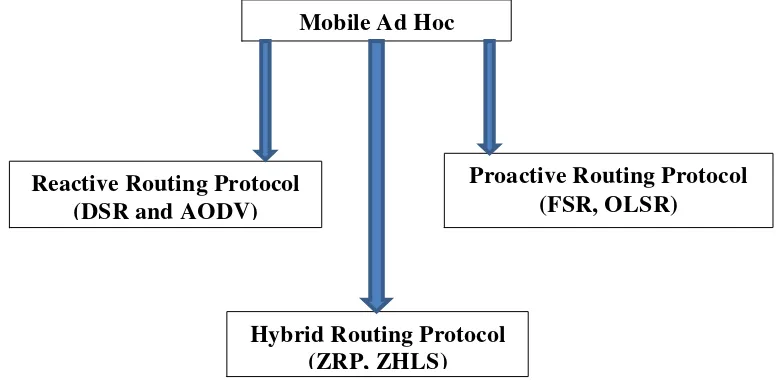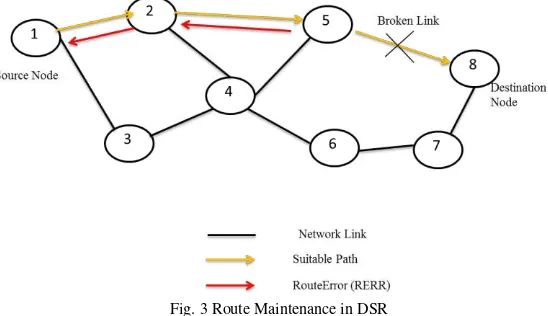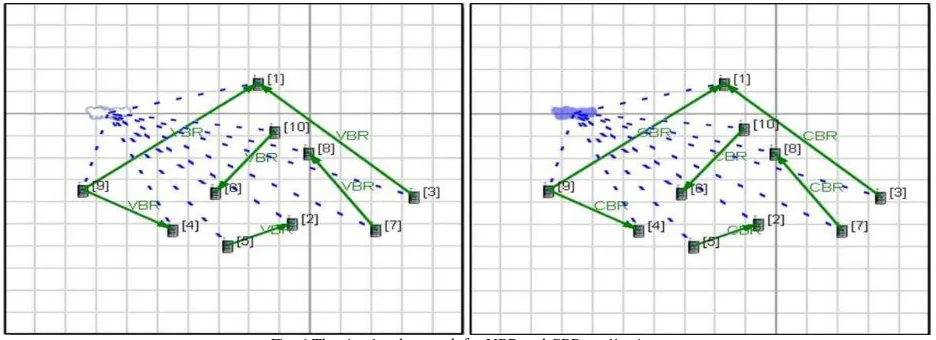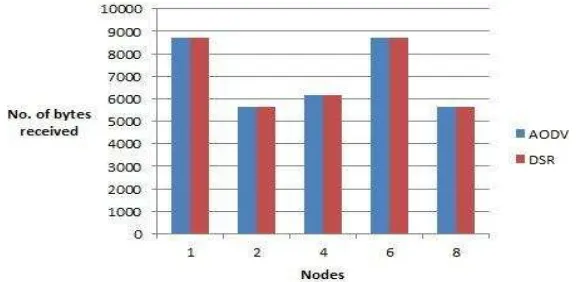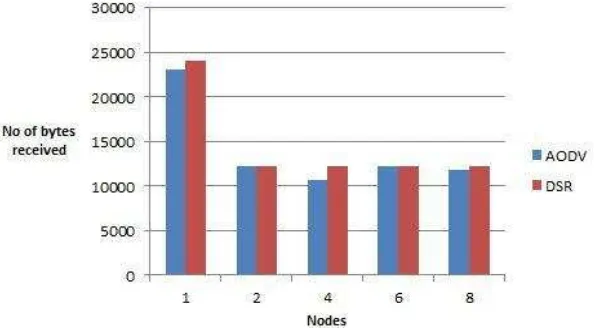International Journal of Advanced Research in
Computer Science and Software Engineering
Research Paper
Available online at:
www.ijarcsse.com
Analysis of AODV and DSR Routing Protocols for a Static
Ad Hoc Network Using Qualnet Network Simulator
Ambica Raina, Akhil Gupta, Dr Rakesh Kumar Jha
SECE, SMVDU India
Abstract— In wireless Ad Hoc networks, the connectivity is affected due to often changing network topology and multiple hopping. Frequent changes in the network give rise to the need of the component dynamic routing protocol. In this paper, analysis of two prominent on-demand routing protocols: Ad Hoc On-Demand Distance Vector (AODV) Routing and Dynamic Source Routing (DSR), for the static Ad Hoc network is compared on the basis of throughput, jitter and data received at the server. In static Ad Hoc scenarios, performance of Dynamic Source Routing (DSR) is better than Ad Hoc On-Demand Distance Vector (AODV) as the information of the route is always present in the cache, which avoids the route discovery process. DSR is preferred because the result analysis depicts that throughput and data received at the server is high and jitter is low for DSR as compared to AODV.
Keywords— AODV, DSR, Throughput, Jitter, CBR, VBR
I. INTRODUCTION
In an Ad Hoc network, communication between the nodes is possible with the multi-hop wireless links present in the network. Every node in the network will serve as a router, forwarding data packets for every other node. Dynamic routing protocols produce a challenge in the design of Ad Hoc networks for efficiently finding routes between two communicating nodes. Now a days interest in this field is renewed due to the introduction of laptops having low cost and palmtops with radio interfaces. Further ignition of the interest is due to the increasing requirement in running common network protocols in real time application without making any changes in specific infrastructures. In this paper, the main objective is to work out a systematic study of the performance of two dynamic routing protocols for Ad Hoc networks: the Dynamic Source Routing protocol (DSR) [1, 2] and the Ad Hoc On-Demand Distance Vector protocol (AODV) [3, 4].
Fig. 1 Classification of Routing Protocols
An interesting characteristic that both DSR and AODV shared is about initiating routing activities on an on demand basis. This interesting characteristic of both protocols is an important departure from previous protocols, which find routes between every source-destination pair regardless of the use or need for such routes. The main objective behind the design of on-demand protocols [5] is to reduce the routing load. High routing load has an important impact on low-bandwidth wireless links. Source routing feature is the main difference between DSR and AODV. DSR is a source routing protocol, which contains all the routing information is maintained at the mobile nodes. DSR computes and updates the routes. In source routing technique the source identifies the complete sequence of the nodes through which the data has to pass. Then packet sender lists the route in the header of the packet so that the next receiver node can be
January - 2014, pp. 736-741
identified by the successive addresses towards the destination node. AODV is using the combination of a DSR and DSDV mechanism. DSR is used for route discovery and route maintenance and DSDV is used for hop-by-hop routing, periodic advertisements and sequence numbers. Thus AODV completely removes the problem of counting to infinity and Bellman Ford problem with quick convergence whenever any alteration is performed or occurred in Ad Hoc network topology.
The remaining paper is organized as follows. In section II, Routing Protocols are described by comparison and section III and IV involves the Simulation Parameters and Result Analysis respectively. The paper is concluded in section V
II. ROUTING PROTOCOLS A. Dynamic Source Routing (DSR)
The key feature which differentiates DSR [1, 2] from other routing protocols is source routing i.e. the complete path followed by the data packet is stored in a route cache. The header field of the data packet contains the source route, which contains complete hop by hop path from source to destination.
In an Ad Hoc network, when a source node needs to send data to a destination node, it has to follow the route discovery process to determine the efficient path between source and destination.
Fig. 2 Route Establishment in DSR
In the route discovery process, the route request packets are flooded in the given network. After receiving the route request packet, the nodes rebroadcast it. This process is followed again and again till the next node is the destination or the node knows the path towards the destination. When the destination node receives the packet, it replies with the route reply packet, which is sent towards the source. Both the route request and route reply packets are source routed. The route reply packet while returning towards the source carries the path travelled by packet, which is stored in the cache of the source node.
Fig. 3 Route Maintenance in DSR
When the link of a source route which is stored in source node is broken by any way, the source node removes that route from its cache as it receives the route error packet. If the source node needs the removed route, then it has to follow route discovery process.
B. Ad Hoc On-Demand Distance Vector (AODV)
January - 2014, pp. 736-741
formation of routing loops and maintaining freshness of routing information [3]. These sequence numbers are drifted by all routing packets.
Fig. 4 Route Establishment in AODV
AODV make use of time based states for every node to completely utilize respective routing table entries. If the routing table entry is not being utilized recently, it gets expired. A complete set of immediate ancestor nodes is maintained for every routing table entry which indicates the set of neighbouring nodes which make use of that entry to route data packets.
Fig. 5 Route Maintenance in AODV
When the link of the next hop, breaks, these nodes are notified with router error packets. Every immediate ancestor node will forward the route error in its own set of immediate ancestors, thereby completely removing all routes using the broken link. Route error packets in AODV inform all sources about the failure using a link which is in contrast to what is done in DSR. Thus Route error proliferation in AODV is like a tree with the root is the node at the point of failure and leaves are the sources that are using that failed link.
III.SIMULATION PARAMETERS
In this section, the effect of two on-demand routing protocols, namely Ad-hoc On Demand Distance Vector (AODV) protocol and Dynamic Source Routing (DSR) protocol are analyzed on static ad-hoc network. The analysis is made on the basis of throughput, jitter and data reception at VBR and CBR servers respectively. The Qualnet network simulator is used to simulate the network. The simulated network is shown in Fig 6.
January - 2014, pp. 736-741
The simulation parameters for a two ray pathless model having 2.4GHz channel frequency and 90sec as simulation time is shown in Table I (A) and Table I (B).
TABLEI(A)
SIMULATION PARAMETERS FOR PHYSICAL AND MAC LAYER
S.No. Layer Parameter Value
S.No. Routing Protocol Parameter Value
1 AODV Network diameter 35 hops
In this section, we have used clustered column histogram to compare throughput, jitter and no. of bytes received by server end for both the protocols in terms of VBR and CBR applications.
A. VBR Comparison
Fig 7 shows a comparison of AODV and DSR routing protocols using VBR application. It is clear from the histogram that number of bytes received at server remains unaffected even after changing the routing protocols.
Fig. 7 Comparison of no. of bytes received on VBR server nodes
B. CBR Comparison
Fig 8, 9, 10 shows the comparison of AODV and DSR routing protocols using CBR application.
January - 2014, pp. 736-741
Fig. 8 Comparison of throughput on CBR server nodes
2) Jitter: Fig 9 shows the comparison of jitter at server nodes for AODV and DSR routing protocols. It is clear from the figure shown below that there is a decrease in jitter at the end CBR nodes, while the jitter is high for the CBR server nodes placed inside the end nodes.
Fig. 9 Comparison of jitter on CBR server nodes
3) Data Received: Fig 10 shows the comparison of the number of bytes received at CBR server nodes for AODV and DSR routing protocols, and it’s clear from the figure that the number of bytes received by CBR server nodes is either same or higher in case of DSR routing protocol. So, it’s clear that data loss in case of the DSR routing protocol is less, hence DSR is better routing protocol.
Fig. 10 Comparison of no. of bytes received on CBR server nodes
V. CONCLUSIONS
January - 2014, pp. 736-741
REFERENCES
[1] J. Broach, D. Johnson, and D. Maltz. “The Dynamic Source Routing Protocol for Mobile Ad Hoc Networks,” http://www.ietf.org/internet-drafts/draft-ietfmanet- dsr-03.txt, IETF Internet draft, Oct. 1999, work in progress.
[2] D. Johnson and D. Maltz, “Dynamic Source Routing in Ad Hoc Wireless Networks,” T. Imielinski and H. Korth,
Eds. Mobile Computing, Ch. 5, Kluwer, 1996.
[3] C. E. Perkins and E. M. Royer, “Ad Hoc On-demand Distance Vector Routing,” Proc. 2nd IEEE Workshop. Mobile
Comp. Sys. and Apps., Feb. 1999, pp. 90–100.
[4] C. E. Perkins, E. M. Royer, and S. R. Das, “Ad Hoc on Demand Distance Vector (AODV) Routing,
http://www.ietf.org/internet-drafts/draft-ietfmanet- aodv-06.txt, IETF Internet Draft, July 2000, work in progress [5] D. Maltz et al., “The Effects of On-demand Behavior in Routing Protocols for Multihop Wireless Ad Hoc
Networks,” IEEE JSAC, vol. 17, no. 8, Aug. 1999
[6] D. Eckhardt and P. Steenkiste, “Measurement and Analysis of the Error Characteristics of an In-building Wireless
Network,” Proc. ACM SIGCOMM ’96, Oct. 1996, pp. 243–54
[7] P. Johansson et al., “Routing Protocols for Mobile Ad-hoc Networks –A Comparative Performance Analysis,” Proc.
IEEE/ACM MOBICOM ’99, Aug. 1999, pp. 195–206
[8] G. Holland and N. H. Vaidya, Analysis of TCP Performance Over Mobile Ad Hoc Networks,” Proc. IEEE/ACM
MOBICOM ’99, Seattle, Aug. 1999, pp. 219–30
[9] S. R. Das et al., “Comparative Performance Evaluation of Routing Protocols for Mobile Ad Hoc Networks,” 7th
Int’l Conf. Comp. Commun. and Networks, Oct. 1998, pp. 153–61.
[10] M. Abolhasan, T. Wysocki and E. Dutkiewicz, “A review of Routing Protocols for Mobile Ad Hoc Networks”, Ad Hoc Networks, Vol. 2, issue1, pp. 122, Jan.2004.
[11] Joseph Macker and Scott Corson, “Mobile Ad Hoc networks (MANET)”.
http://www.ietf.org/proceedings/01dec/183.htm, December 2001.
[12] Jun-Zhao Sun, “Mobile Ad Hoc Networking: An Essential Technology for Pervasive Computing,” Proceedings of
International conference on info-tech and info-net, Vol-3, pp. 316-321, 2001.
